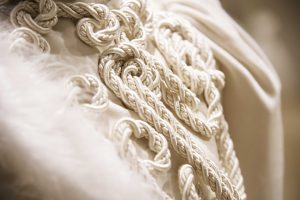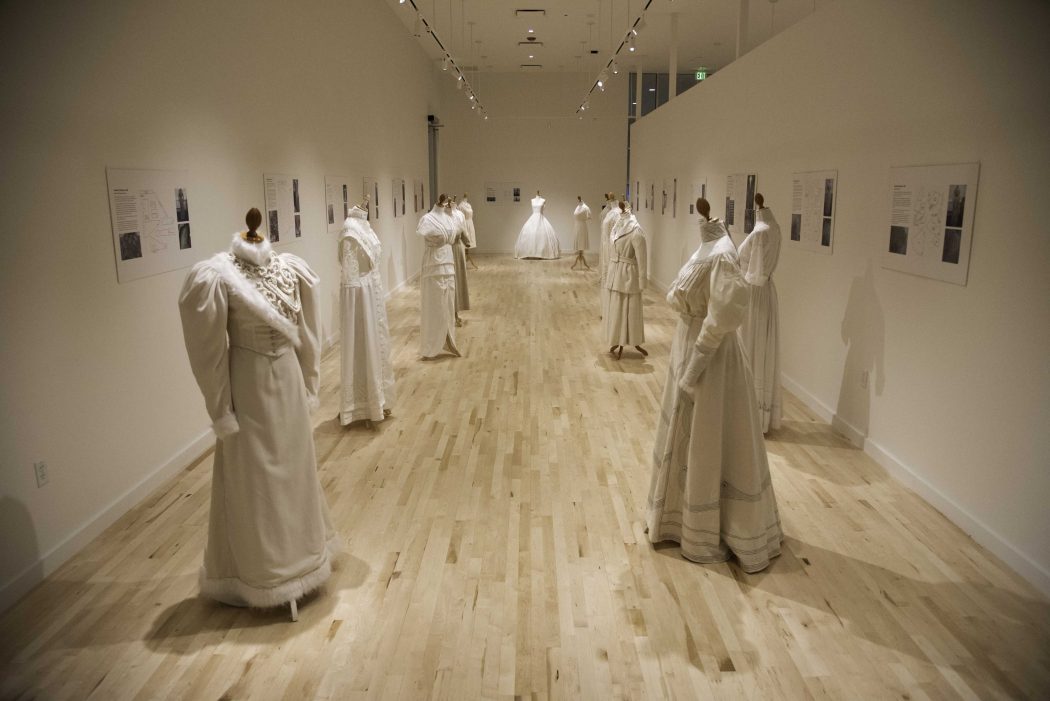‘More Shades of White’ exhibit finds its home at USU
When traveling to an estate in the English countryside, Nancy Hills, head of theater costume design at Utah State University, uncovered a wealth of historical knowledge through clothing.
Hills has always had a interest in historical clothing since a young age.
“I would look at movies and connect it to old photos of my family I had seen. I could date movies by what they were wearing,” Hills said.
This passion for historical clothing and her expertise in designing costumes for the theater had led her to come into contact with the Snowshill clothing collection housed at Berrington Hall in Great Britain. Hills was able to handle and see many different pieces of historical clothing that had once been worn and used.
“Every year I would go back there and Althea at Berrington Hall would keep showing me stuff. I thought there has to be something that I can do with this,” Hills said.
With the help of her colleagues in Britain, Hills applied for the Janet Arnold Award grant from the Society of Antiquaries in London. She received the grant and set to work recreating these historical dresses.
Hills worked with the extensive collection for many weeks analyzing and studying the clothing to get it just right.
“I take the dress out and I’ll sketch what the I think the pattern would look like. Then I make those full size,” Hills said. “I spend a day or two cutting out paper and making sure it’s right. I spent many weeks in this little town in these museums doing this.”

After spending time with around 55 historical garments, Hills had completed several dresses. In 2014, She was invited to give a lecture at the Society of Antiquaries in London. It just so happened that Utah State students were on study abroad there at the same time, so Hills used them to model the dresses.
When Hills isn’t working on the dresses, she helps advise study abroad trips to Europe for Utah State students every summer.
Since then, Hills’ work has received many praises and she’s added more dresses to the collection with the help of other seamstresses and students. The dresses and Hills’ work was displayed in Great Britain for many months, but then finally found its way home to Utah State University.
“This is the biggest exhibit I’ve ever done in the U.S. I left them in England for awhile, but since I go back so regularly I started bring them back with me because I wanted to show them here. Now that a space was clear, the time was here to have them on display at the university,” Hills said.
The five-year project has evolved in what is now known as “More Shades of White.” The dresses featured are based off of original garments and showcase styles from 1735 to 1934. Some of the dresses include a wedding dress, nightgown, tennis dress and many more styles. Hills said students can see history change and women’s lives along with it while walking through the exhibit.
“You can see the evolution of women’s lives from the 18th to 20th century and there is moments where they completely change,” Hills said.
Recently at the opening reception for the exhibit, Hills had some of her students come and model the dresses for the public.
Sallie Hull, theater costume design major, was one of the students chosen to be apart of the exhibition. Hull wore a 1898 Victorian dress.
“It was cool wearing a pattern piece that was patterned off an original garment. I love Victorian clothes, so being put in Victorian clothes I was like ‘oh yeah I love this.’ It was cool being apart of the exhibit and being able to model and it wasn’t too far off from how I like to dress normally as well,” Hull said.
The exhibit is now on display in the Tippetts & Eccles Galleries in the Chase Fine Arts Center. Students can walk through the collection of white dresses and experience the history for themselves.

Lyndsey Knowles, psychology major, walked through the exhibit on Wednesday afternoon. She enjoyed the new addition of art to the campus.
“I think that it is really neat that we are able to have people like Nancy Hill, Patrick Dougherty and other types of artists come to USU. It shows that they respect and value our education because they want to share their work with us. As a school, it puts us more on the map having exhibits and artwork being displayed,” Knowles said.
—shelby.black@aggiemail.usu.edu
@shelbsterblack

